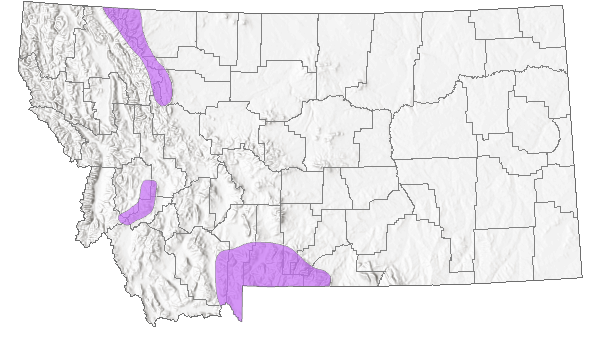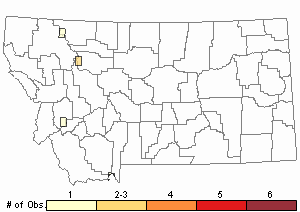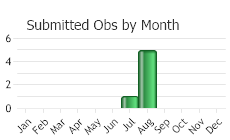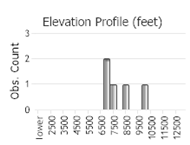View in other NatureServe Network Field Guides
NatureServe
Montana
Utah
Wyoming
Idaho
Wisconsin
British Columbia
South Carolina
Yukon
California
New York
Coastal Sand Sedge - Carex incurviformis
Other Names:
Carex maritima var. incurviformis
State Rank Reason (see State Rank above)
Five known occurrences in Montana, three are in Wilderness areas or Glacier National Park. However, all populations are apparenly small to moderate in size based on limited survey data for the species. All occurrences are in alpine habitat that is not generally subject to human impacts.
General Description
Short-rhizomatous. Stems erect to ascending, 2–15 cm, loosely tufted. Leaves mainly basal; blades ca. 1 mm wide. Inflorescence 3 to 5 bisexual spikes, densely clustered in a hemispheric head; lowest bract inconspicuous. Spikes ca. 5 mm long; male flowers above, inconspicuous; female below. Perigynia ascending, glabrous, narrowly ellipsoid, ribbed, 3.5–4 × 1–2 mm, green to brown, with an indistinct, mostly entire beak 0.5–1 mm long; stigmas 2. Female scales brown with hyaline margins, shorter than the perigynia. Achene 2-sided, slightly smaller than the perigynium (
Lesica et al. 2012. Manual of Montana Vascular Plants. BRIT Press. Fort Worth, TX).
Lesica (2012) treats this species as
Carex maritima Gunnerus.
Phenology
Fruit mature in July.
Diagnostic Characteristics
Carex breweri and C. capitata occur at high elevations, but they have solitary spikes that are not subtended by papery bracts as long as the spikes. Carex douglasii does not occur in subalpine or alpine habitats. Carex microptera and C. haydeniana have male flowers (recognized by old anthers) at the base of the spikes. A hand lens or microscope will be needed to observe these characters.
Species Range
Montana Range
Range Descriptions

 Native
Native
Range Comments
Circumpolar south to CA and CO (Lesica et al. 2012. Manual of Montana Vascular Plants. BRIT Press. Fort Worth, TX).
Observations in Montana Natural Heritage Program Database
Number of Observations: 6
(Click on the following maps and charts to see full sized version)
Map Help and Descriptions
Relative Density

Recency



 (Observations spanning multiple months or years are excluded from time charts)
(Observations spanning multiple months or years are excluded from time charts)
Habitat
Wet rock ledges and moist tundra in the alpine zone.
National Vegetation Classification System Groups Associated with this Species
Alpine
Alpine - Sparse and Barren
Alpine - Vegetated
Wetland and Riparian
Alpine Riparian and Wetland
Stewardship Responsibility
Threats or Limiting Factors
STATE THREAT SCORE REASON
Threat impact not assigned because threats are not known (MTNHP Threat Assessment 2021).
References
- Literature Cited AboveLegend:
 View Online Publication
View Online Publication Lesica, P., M.T. Lavin, and P.F. Stickney. 2012. Manual of Montana Vascular Plants. Fort Worth, TX: BRIT Press. viii + 771 p.
Lesica, P., M.T. Lavin, and P.F. Stickney. 2012. Manual of Montana Vascular Plants. Fort Worth, TX: BRIT Press. viii + 771 p. MTNHP Threat Assessment. 2021. State Threat Score Assignment and Assessment of Reported Threats from 2006 to 2021 for State-listed Vascular Plants. Botany Program, Montana Natural Heritage Program, Helena, Montana.
MTNHP Threat Assessment. 2021. State Threat Score Assignment and Assessment of Reported Threats from 2006 to 2021 for State-listed Vascular Plants. Botany Program, Montana Natural Heritage Program, Helena, Montana.
- Additional ReferencesLegend:
 View Online Publication
View Online Publication
Do you know of a citation we're missing? Lesica, P., M.T. Lavin, and P.F. Stickney. 2022. Manual of Montana Vascular Plants, Second Edition. Fort Worth, TX: BRIT Press. viii + 779 p.
Lesica, P., M.T. Lavin, and P.F. Stickney. 2022. Manual of Montana Vascular Plants, Second Edition. Fort Worth, TX: BRIT Press. viii + 779 p.
- Web Search Engines for Articles on "Coastal Sand Sedge"





